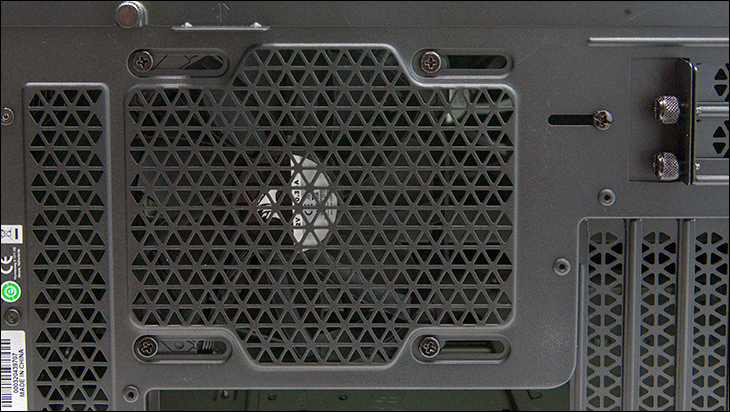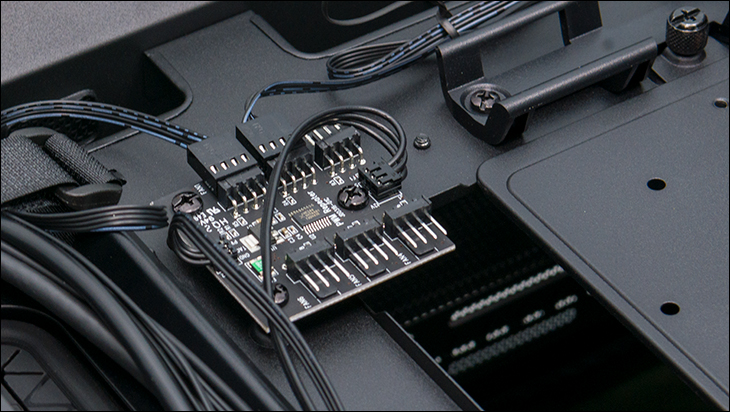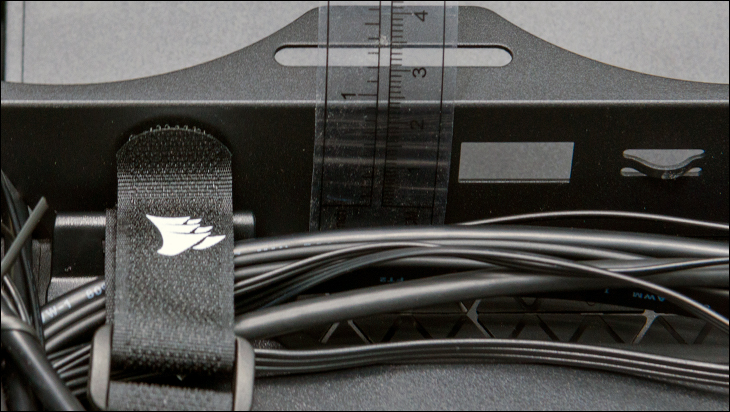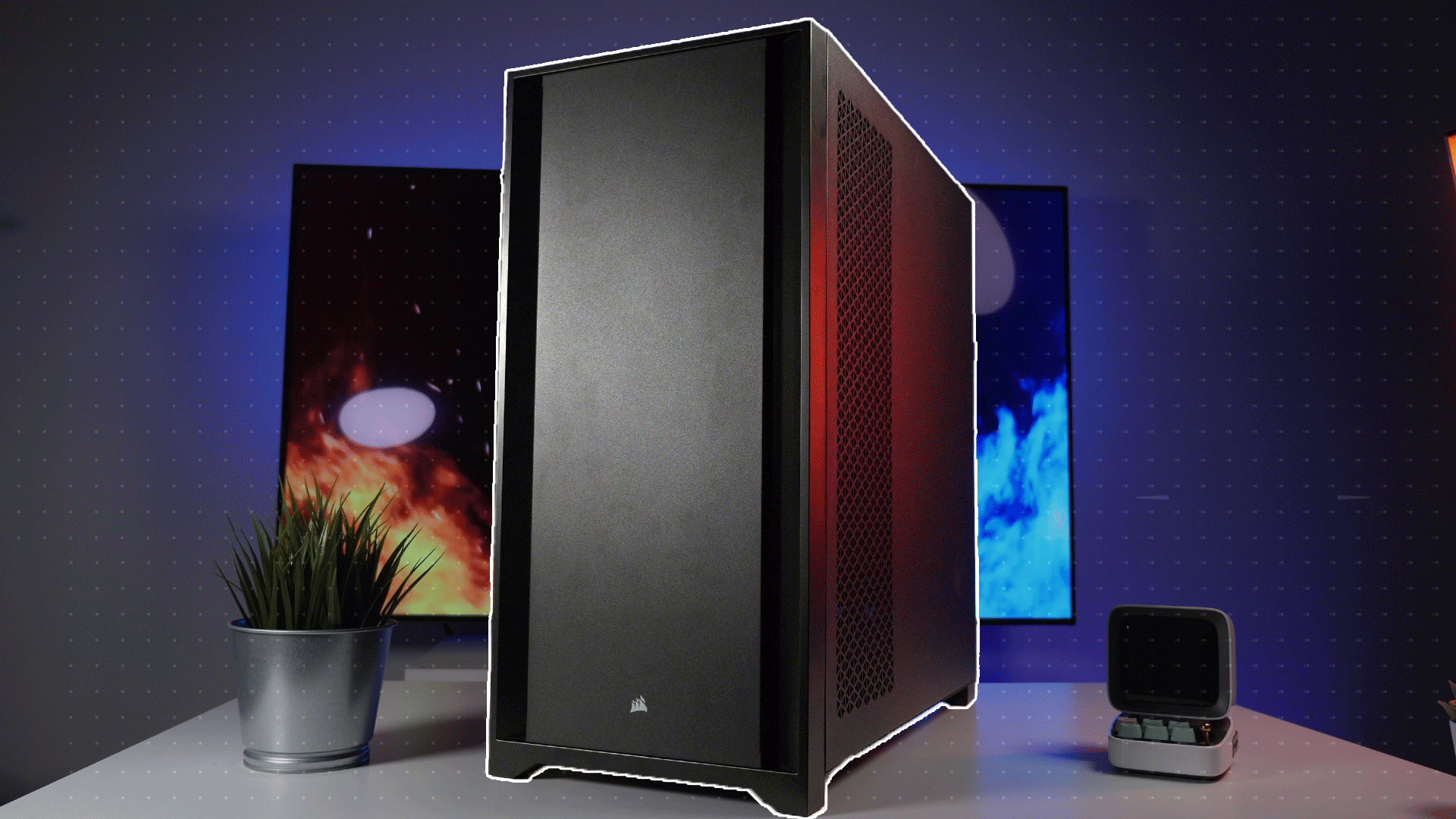
Circling around to the back of the case we come to two of the few compromises necessary to meet typical mid-tower dimensions. We have already gone over the 7+2 PCIe slot configuration (with their knurled bolts and nicely ventilated blanking panels), but the other one is… interesting.

We know of many mid-tower cases that can accommodate 140mm rear exhaust fans. The Corsair 5000D is not one of them. Instead, it only allows for 120mm form-factor rear case fans. On the positive side it can be adjusted up or down a good inch or more so while you will not be able to use a good single bay AIO or radiator here (i.e. ‘140mm’ rads) it does allow for a lot of ‘wiggle room’ when it comes to oddball motherboards with varying heatsink layouts as well as PCIe slot layouts. We just wish it could accept 140mm fans. Solid-sided cases need all the airflow they can get to keep high end (E.G. AMD ThreadRipper) systems cool and happy. Especially when using air-based CPU cooling solutions. Having a nice and big, and high static pressure, rear exhaust fan can go a long way to keeping temps and case noise in check.

Like the vast, vast majority of cases the Corsair 5000D uses a bottom mounted, ‘horizontal’ configuration for the PSU area. Also like the vast majority of cases, the PSU mounting bracket is integrated right into the case itself. I.E. it is not removable. As such you will have to remove the glass panel first, then slide the PSU into place, and then mount it. This certainly is the ‘old school’ or ‘tried and true’ method of doing things but it is slower than a removable PSU bracket that is attached to the PSU and then it is slid into position via the back of the case and then secured with four bolts.

By the same token this tried-and-true method of PSU mounting is simply better than how the Lian-Li does things. Next to trying to get enough air flow in the O11 Dynamic the PSU mounting location is the biggest con of that case. This is because Lian-Li has gone for the flashy ‘DUAL PSU Mounts!!!’ gimmick which means vertical PSU mounts behind the motherboard tray – which we dislike for both its orientation and location. That is not to say the Corsair 5000-series is perfect. In default ‘out of the box’ configuration (i.e. with 2-bay HDD cage installed in its factory location) you have a grand total of about 7.5 inches for the power supply and its cables. Most decent 750 watt PSUs are 5.5-6 inches long giving you about 1.5-2 inches for the cables to be plugged in… so its tight, but not terribly so. By the same token a lot of higher wattage are going to be tight. For example Seasonic Prime 750 is 140mm but 850watt and higher are 170mm… not including the cables plugged into it. We strongly recommend moving the drive cage as far forward as possible. Since the drive cage is held in place with 4 knurled thumb screws this is a mere moments worth of work and not much of a hardship… and will give you another inch or so of room. This additional slot and ability to move the drive bay forward is new to the 5000 series and just underscores how Corsair listens to complaints and then fixes them.

This however brings up a ‘you have 3 options, choose any two’ type deal. You can have lots of room for the PSU and the drive cage… or you can have a front (or side) mounted 3-bay radiator and tons of room for the PSU. You cannot have all three at the same time. This is because that lovely low-profile bracket requires you to leave the 2-bay drive mount in its default location. This should come as no real surprise as this is (technically) a mid-tower case and certain compromises in the overall room department have to be made.

On the positive side, the 2-bay drive cage does use decent, albeit plastic, drive sleds that allow for tool free mounting of 3.5-inch drives. They will of course work with 2.5-inch form-factor storage but you will have to use screws to mount them.

When you remove the ‘other side’ metal case panel you will be greeted by another hinged door covering about 3/4 the width (and basically full height) of the 5000D. Hidden underneath you will find three 2.5inch vertical drive mounts, a single 2.5/3.5-inch drive mount (covering the generously sized motherboard cutout for ease of CPU cooling solution backplates and with all four drive caddies held in place via tab and knurled screw affair) a cable tidying area, and a six 4-pin fan hub allowing for 6 fans to be controlled via a single free fan header on your motherboard.

The little 6 fan hub’s voltage regulator is a Nexperia 74HC244 which is powered via a standard SATA power cable (just as the 4000-series was).

Equally important this entire sectioned off area is about 1inch deep making it rather easy to route all your cables and still be able to easily reinstall the (outer) side panel… without any unsightly bulges.

Switching back over to the other side we can see that the 5000D’s motherboard area comes with standoffs for E-ATX / ATX preinstalled and all the rest are clearly labeled. About an inch past the E-ATX zone there is a full length ‘spoiler’ that has enough of a gap that you can slip a lot of various cables (SATA, front I/O, etc) here and have them nicely hidden from view. Put bluntly, for a mid-tower case this is a rather roomy motherboard ‘zone’. One that unless your motherboard is a server or oddball form-factor you should have zero worries over if it will fit or not… plus it makes for one clean build with cable tidying being rather easy. Overall, there may be a few compromises done by Corsair to make it (kinda-sorta) fit the mid-tower case form-factor but for the most part this is a rather impressive piece of engineering. Color us impressed.











